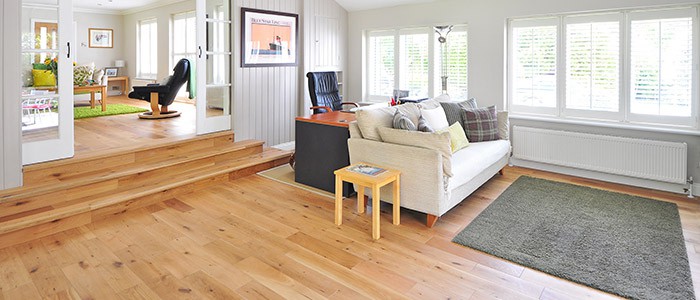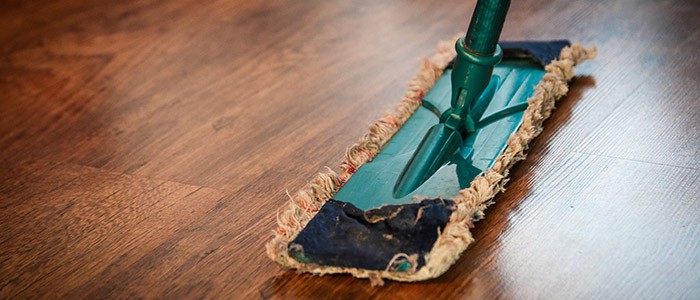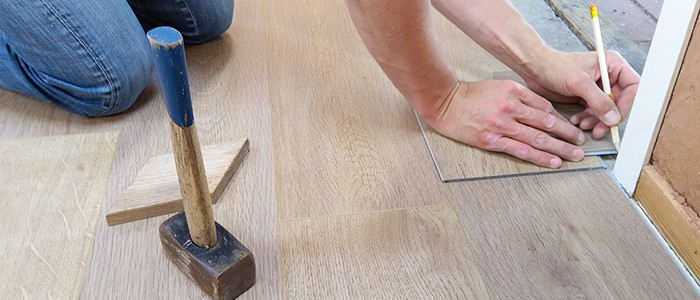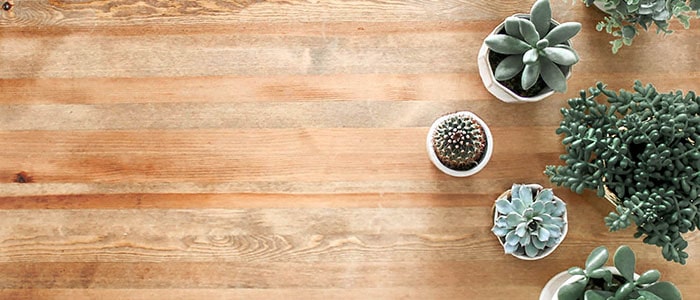If you like the look of traditional hardwoods, but don’t have the budget vinyl plank or laminate flooring could be a great option.
This guide will give you a quick rundown of each floor type: vinyl plank vs. laminate and help you decide which flooring material is best for your application.

| Feature | Vinyl | Laminate |
|---|---|---|
| Appearance | Printed image layer | Printed image layer |
| Durability | Good | Good |
| Care & Maintenance | Easy | Easy |
| Approved Locations | Dry + Damp | Dry + Damp |
| Cost | $2-8/installed | $3-8/installed |
| Sizes | Tile, Plank, or Sheet | Tile, Plank, or Sheet |
| Install | Pro or DIY | Pro or DIY |
| Moisture | Water-resistant | Water-resistant |
| Pets | Pet-friendly | Pet-friendly |
| Sound Absorption | Good | Average |
| Eco-friendly | Average | Good |
| Find A Local Installer | Find a Pro | Find a Pro |
| Materials | Check Price | Check Price |
Table of Contents
- Appearance
- Durability
- Care & Maintenance
- Application
- Cost
- Sizes
- Install
- Moisture
- Pets
- Sound
- Eco-Friendly
- Which is right for you?
What is it made of?

What’s vinyl plank flooring made from?
Vinyl plank flooring is made of vinyl (plastic), an image layer, and a sealant. The layers further break down as shown below:
- Back layer: backing of vinyl plank flooring is generally made of a PVC composite
- Core layer: although exact make-up varies by manufacturer, the core layer is usually some type of fiberglass, PVC, stabilizer, or a combination of them all
- Image layer: a thin layer that the product image is printed onto to mimic the look of other flooring materials
- Wear layer: top clear layer that protects the image from wear, scratches, chips, or cracks
What’s laminate flooring made from?
Laminate flooring is made up of pressed wood, an image, and a sealant. The layers further breakdown as shown below:
- Back layer: wood substrate that provides durability and structural integrity to the material
- Core layer: generally multiple layers of pressed wood to create a high-density composite layer
- Image layer: a thin layer with a printed high-resolution photograph of the floor aesthetic
- Wear layer: top layer that is a clear blend of aluminum oxide that protects the floor from wear and tear, like fading, stains, and scratches
1. Appearance
Vinyl Plank
Mimics wood, stone, concrete, brick, patterns, or textiles
Laminate
Mimics wood, stone, concrete, brick, patterns, or textiles
Both vinyl plank flooring and laminate plank flooring are chameleons in the design world. They are affordable flooring alternatives that are designed to mimic the look of more expensive flooring styles.

Some of the most common appearances of vinyl plank and laminate include:
- Hardwood (most popular)
- Natural stone
- Tile
- Concrete
- Graphic pattern
- Textile
2. Durability
Vinyl Plank
Good
Laminate
Good
Vinyl plank flooring and laminate flooring are similar when it comes to durability. Although laminate is wood and vinyl is plastic, both have a comparable top wear layer which means they are susceptible to the same types of damage— scratches, fading, stains, etc.
Both floors also have printed image layers above various core layers. The printed image can be damaged
3. Care & Maintenance
Vinyl Plank
Good
Laminate
Good
Taking care of vinyl and laminate flooring is simple and straightforward.
How to clean vinyl and laminate?
To clean both floors, you can dry sweep or damp mop. Avoid full well mopping due to the danger of too much water exposure at the seams.

How to repair vinyl and laminate?
This is a bit of a trick question since vinyl or laminate flooring can’t really be repaired. If the image layer is damaged, you’ll need to remove the plank entirely and replace it.
Unlike traditional hardwoods, you can not sand and refinish vinyl or laminate floors.
Do you need to seal vinyl or laminate flooring?
The short answer to this is no.
With some manufacturers, adding after-market sealant can even void the warranty. Vinyl and laminate planks are designed with the top “wear layer” providing all of the sealant protection that it needs.
Some people continue to swear by additional sealants. But keep in mind, if you decide to go this route, you’ll need to select one that is approved by the manufacturer.
4. Cost
Vinyl Plank
$2-8/sf installed
Laminate
$3-8/sf installed
The cost difference between vinyl plank and laminate flooring is pretty negligible. The materials are similar, but vinyl plank may be slightly less expensive, depending on the quality you’re looking for.
Install methods between the two materials are comparable so pricing would be about the same to install.
QUOTE – Need a price for your project? Click here to get an instant quote from local contractors.
5. Application
Vinyl plank flooring and laminate flooring have some overlap in terms of approved application areas. Both flooring types are good options for living, dining, and entry spaces.

They are also suitable for wet spaces like kitchens and bathrooms, but come with one word of caution— seams.
What rooms is vinyl and laminate best for?
| Location / Room Type | Vinyl | Laminate |
|---|---|---|
| Kitchen | Maybe | Maybe |
| Bathroom | Maybe | Maybe |
| Laundry | Yes | Yes |
| Entry | Yes | Yes |
| Common Room | Yes | Yes |
| Gym | Yes | Yes |
The surface of vinyl plank and laminate flooring is waterproof, but the seams are not. With a flawless install, these flooring types could be virtually waterproof, but any variation in seams can cause gaps where water could settle and damage the flooring.
6. Sizes
Vinyl Plank
Varies
Laminate
Varies
Laminate and vinyl flooring come in various sizes. The three main styles that are available include:
- Tile: generally square (like 12×12″ or 24×24″) or rectangle (12×18″ or 18×36″)
- Plank: narrower and longer than tile (like 6×36″) and mimics the size of wood planks
- Sheet: rolls of vinyl or laminate; better for the most waterproof performance

7. Install
Vinyl Plank
Pro or DIY
Laminate
Pro or DIY
When planning on installing flooring, it may be a deciding factor whether or not it requires a professional or if it can be done by yourself. Installing flooring yourself can save you thousands in install cost, but there may also be a learning curve or significant time required to complete the job.

When it comes to vinyl vs. laminate planks, there are three install methods:
- Floating: This install method does not require any glues or adhesives and can even be applied directly over an existing floor.
- Direct-glue: Similar to floating, this method can be applied over an existing floor, but in this case, glue is used to adhere the tiles or plans to the substrate.
- Peel-and-stick: Some manufactures produce a line of “peel-n-stick tiles” which have a protective paper backing that peels off and allows you to apply it directly to the floor with adhesive already applied to the tile. This install is the ultimate of time-saving, DIY dream.
Planks can come as end-to-end or click-together edges. The click-together edges have ridges that overlap and lock into place during install. This helps to create a tighter seam and reduce the chance of water damage.
Both vinyl plank and laminate plank are also available with the underlayment already attached. This saves time and makes them easier for DIY install.
PRO INSTALL – Get a quote from a professional installer in your local area now.
8. Moisture
Vinyl Plank
Water-resistant
Laminate
Water-resistant
I’m hesitant to truly use the word “waterproof” when it comes to vinyl plank and laminate flooring. While it’s true that the surfaces of these materials are water-resistant, the seams are points of weaknesses for both flooring types.

What can you do to protect from water?
- Use sheet vinyl. Sheet vinyl flooring has minimal seams and would be less likely to have water damage.
- Go wide. Choosing wider vinyl or laminate planks is another way to minimize the number of seams.
- Install a moisture barrier under the floor. Adding a moisture layer as you’re installing is a great way to protect the sub-floor and underlayment from water damage.
- Select a click-together install. Click-together vinyl or laminate planks are more waterproof than planks that just butt together, end-to-end.
9. Pets
Vinyl Plank
Pet-friendly
Laminate
Pet-friendly
Pets can cause damage to any flooring, but how does vinyl plank and laminate flooring stand up in particular?

Again, vinyl and laminate flooring have the same clear coat top that is the protective layer against wear and tear.
- Scratches: Many vinyl plank and laminate floors are scratch-resistant, but check with the manufacturer first. Ones that don’t specifically say “Scratch resistant”, may scratch, but it won’t be as easily as the sealant on hardwood can scratch. To minimize appearance of scratches, select a floor with a matte finish, instead of traditional gloss.
- Pet Odor: Because of the hard surface of both vinyl and laminate plank flooring, pet odor would not be an issue with this floor type.
- Accidents: Spills caused by pets or “accidents” in the house are also easy to clean up off this floor type. The smooth top coat makes it easy to mop up any spill and move on.
10. Sound Absorption
Vinyl Plank
Good
Laminate
Average
Some floors, like hardwoods or tile, can have quite a bit of reverberation and audio bounce-back. While adding area rugs and upholstered furniture can reduce reverberation, selecting flooring with absorptive qualities is even better.
RELATED: How to Soundproof a Room
Vinyl plank is going to have more sound absorption than laminate because plastic absorbs sound better than wood.
11. Eco-Friendly
Vinyl Plank
Average
Laminate
Good
Last but not least, let’s talk about environmental factors. Are either of these flooring types considered “green”? Short answer, no they’re not. But one is a little more eco-friendly than the other.

Vinyl planks are made from polyvinyl chloride (PVC), which is essentially man-made plastic. There is not really anything environmentally friendly about plastic as it is a non-renewable resource and can have a bit of an odor.
In comparison, laminate flooring is made from layers of pressed wood and adhesives. It is cheaper than hardwood floors because the wood is not solid, but it is still wood, which is a renewable resource.
Vinyl Plank vs. Laminate: Which is right for you?
As you can tell from this guide, vinyl plank flooring and laminate plank flooring are extremely similar in almost all ways. The main differences boil down to these few points.
The Differences
- Composition: Vinyl plank is a mad-made material that is made of plastic. The planks are thinner and flexible. Laminate planks are made of pressed wood. They are thicker than vinyl and are rigid (like traditional hardwood). Both floor types have core layers that are covered with a printed image layer and sealed with a top wear layer.
- Price: Vinyl flooring can sometimes be cheaper than laminate , but it all comes down to image and material quality.
- Environmental factors: Vinyl planks can have some off-gassing and are made of more man-made materials. Plastic vinyl composite material is not a renewable resource and is not recyclable. Laminate, being made of pressed wood, is more natural and has less of an odor.
Your Project
You can find instant quotes from contractors and professional installers in your local here. Click here, fill out the form, get instant quotes. It’s that easy.
Still have questions?
So between vinyl plank vs. laminate, still not sure which flooring type is best for you? No problem. Shoot us a message and we’d be glad to make a custom recommendation for your space.
